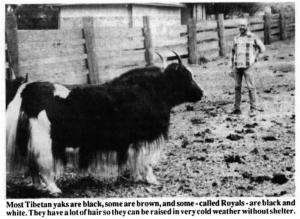1993 - Volume #17, Issue #4, Page #22
[ Sample Stories From This Issue | List of All Stories In This Issue | Print this story
| Read this issue]
Yaks May Be Hottest New Exotic Breed
 |
"They have a prehistoric look to them that a lot of people find fascinating," says Hiebert, who has 50 yaks so far.
Yaks originated in the Himalayas where they're still used as beasts of burden. Most are black, some are brown, and some - called Royals - are black and white. "Royals are the rarest, although they're becoming more common," says Hiebert. "I like brown ones because they're real shaggy. Yaks have a lot of hair so they can be raised in very cold weather without shelter. Cows weigh 800 to 1,000 lbs. and bulls weigh 1,200 to 1,500 lbs., with a few up to 2,000 lbs."
In Tibet and Nepal, the animals' fine hair is combed out in the warm season and used to weave blankets, robes, and garments. Yaks are also used for meat, butter and milk. "The meat is low in cholesterol because most of the fat is stored in the hump on back or in the tail, not in the muscle. The meat is lean and fine-grained with no marbling. Some people crossbreed yaks, with domes-tic beef cattle like shorthorns. The offspring have a higher rate of growth and are larger in size, but the meat is still low in cholesterol and high in protein.
"In addition, yaks don't eat as much as beef cattle and are so hardy that they don't need shelter. I feed mine only grass hay."
"The market for yaks started building in 1987. A mature Royal bull was worth about $3,000 then. Hiebert got into the yak market two years ago after breeding llamas in the 1980's. He says most of his animals are now each worth $2,000 to $5,000. He recently paid $15,000 for a Royal yak cow.
He got many of his animals from the Toronto zoo, which was selling out, as well as from Alberta and South Dakota ranchers.
It's estimated there are only about 450 yaks in North America Hiebert and Larry Richards, Polson, Mont., each own about 50. Jerry McRoberts, of Gurley, Neb., owns the largest herd, about 150. Together, these three own over two-thirds of the total number of female yaks in North America.
The limited supply is largely due to import restrictions. Breeders can't bring yaks into North America from the Far East, where the animals are abundant. "It's mainly a breeding market now because there are so few of them," says Hiebert.
Last September Yak breeders formed the International Yak Society. A "Yakarama" auction is held each September.
For more information, contact: FARM SHOW Followup, Lloyd Hiebert, 3871 Concomly Drive S., Salem, Ore. 97306 (ph 503 399-9446).

Click here to download page story appeared in.

Click here to read entire issue
To read the rest of this story, download this issue below or click here to register with your account number.




